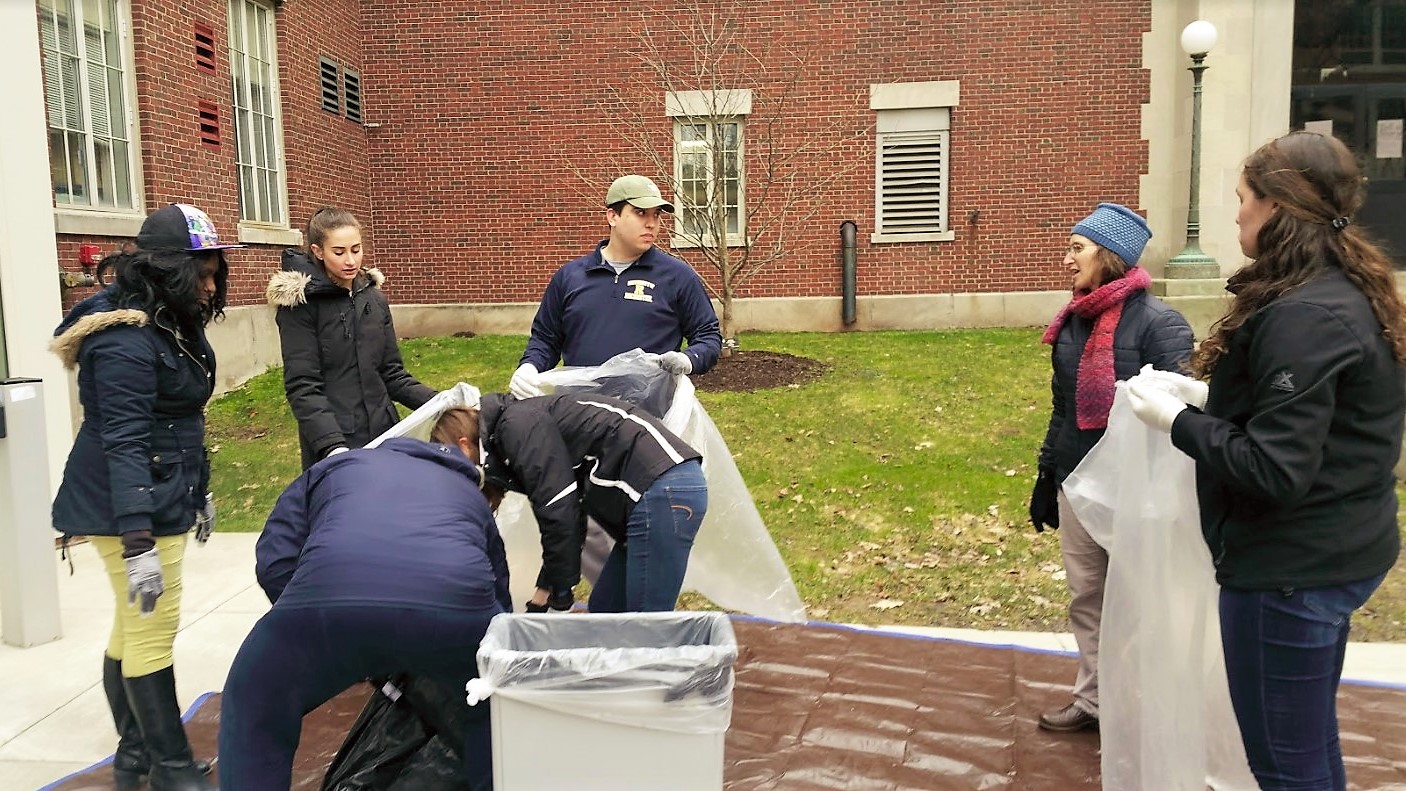In the midst of Earth Day and Local Food Week this April, there were multiple audits conducted to get a better understanding of the waste generated throughout the River Campus. The first was a food waste audit that was organized by Dining Team Green, and the next was a series of waste stream audits held by Karen Berger’s Introduction to Environmental Science class.
Dining Team Green conducted a food waste audit that included two Zero Waste Dinners in Douglass Dining Hall. The two dinners occurred on April 5 and 26 from 5:00 to 8:30 pm. All post-consumer food waste (plate scraps) was collected and measured. The first dinner was intentionally not advertised in order to attempt to get data from a “typical” meal. During this dinner 203.5 pounds of food waste was collected from 636 customers (0.32 pounds per person). The second dinner was advertised with the intention that participants would be more conscious of their waste. But surprisingly, it did not appear to have that effect as 212 pounds of food waste was collected from 624 customers (0.34 pounds of waste per person). While the result was different from previous years, Dining Team Green is taking the data and information collected to figure out ways to reduce food waste in the future.
Another audit was conducted by Professor Karen Berger’s Introduction to Environmental Science class (EES 103). The class analyzed the waste stream on campus as part of a waste management unit. Their goal was to discover how much recyclable or compostable material is found in trash cans that will end up in a landfill, and how much non-recyclable material is found in recycling bins.
The students in the class all followed the same method. They collected discarded material from trash and recycling bins at assigned locations around River Campus. The material was brought to a centralized location and sorted into categories on tarps. The categories included landfill, recyclable paper, recyclable plastic, recyclable glass/metal, and compostable. Each category was individually weighed from each location. After sorting, all recyclable material was recycled, while landfill and compostable material was placed in the trash.
Data was collected from the following locations: Bausch and Lomb Rooms 106 and 109, Rush Rhees Q&I, Sage Art Center, Wilson Commons outside of Starbucks, Rocky’s, the Pit, and Hirst Lounge, Goergen Athletic Center, outside of Genesee Hall, outside of Hillside, outside of the Hoyt Hall theater, Wegmans Hall by Peet’s Coffee, the Eastman Quadrangle, and outside of Connections. Some of these locations included trash cans without a nearby recycling bin, while others were selected in high-traffic areas with adjacent trash and recycling bins. Overall, the class collected data from 12 trash cans and 10 recycling bins around campus.
The first question to examine was the extent to which people on campus properly disposed of recyclable products. The class observed the following: of 9 pounds of paper, only 36% was properly placed in a recycling bin; 40% of 8.3 pounds of plastic was recycled; and 72% of 3.2 pounds of metal and glass was recycled. They further measured 5.5 pounds of organics (compostable, but non-recyclable) in the trash cans, with 0.6 pounds of organics contaminating the recycling bins. There are not currently any locations on campus for a consumer to deposit organic material for composting.
At four locations, more than half of the total mass in the trash cans consisted of recyclable material; these were outdoors in the Eastman Quad, Sage Art Center, Wegmans Hall by Peet’s Coffee, and the lecture halls in Bausch and Lomb. At Sage and Bausch and Lomb, these high rates were partly due to the lack of a nearby recycling bin.
The second question addressed the level of contamination in recycling bins, defined as the percentage, by weight, of non-recyclable material disposed of in a recycling bin. Rates of over 50% were measured outside of Hoyt Hall and outside on the Eastman Quad. Contamination is a concern because it can lead to rejection by facilities staff or at the recycling center of material intended for recycling.
Berger said that a lot of the students who took the class were surprised by what they learned in this unit, both in what can and cannot be recycled, and at the rate at which recyclable materials were placed in trash cans. She hopes to be able to implement some of the ideas that she and the students generated through this analysis to increase recycling and reduce contamination in the near future. Overall these two audits can lay groundwork for future improvements in waste management at the University.
Written by Mariah Greico, Class of 2018

